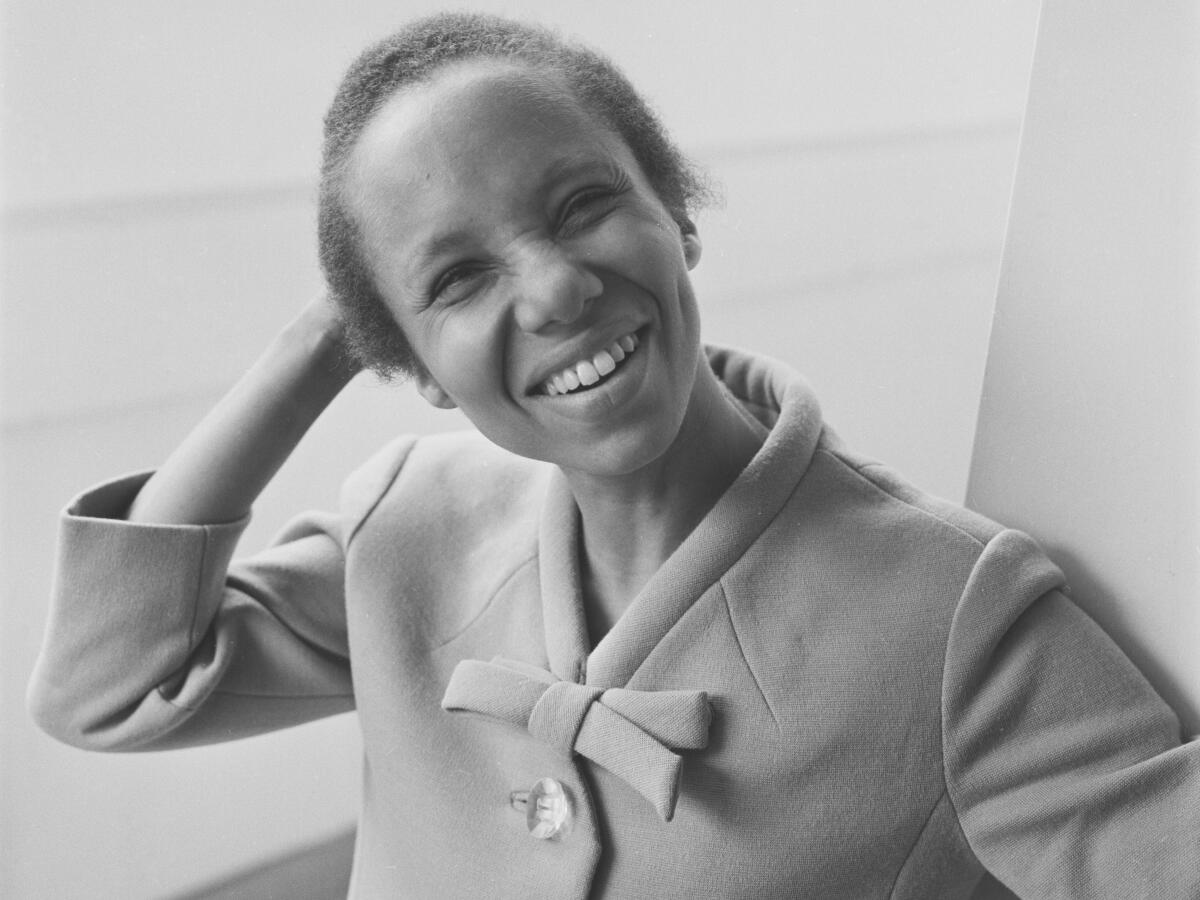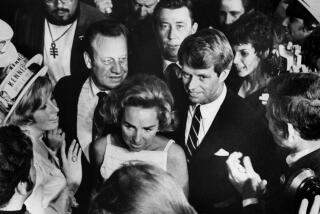Adrienne Kennedy influenced generations of playwrights. An online festival shows why

It is an indictment of our theater that a playwright who has inspired artists across generations is so little known to the average theatergoer. Sadly, Adrienne Kennedy, the 89-year-old African American dramatic poet, whose 1964 play “Funnyhouse of a Negro” is a touchstone of 20th century American drama, is more revered than she is produced.
Her name provokes rapturous tributes from other writers. Branden Jacobs-Jenkins, one of the most talented dramatists to have emerged in the last 10 years, acknowledges the debt he and his contemporaries owe: “Every playwright writing today writes in Adrienne Kennedy’s shadow, full stop.” Years of teaching her plays has shown me how her work quickens the sensibilities of young artists.
Yet in my long career of professional theatergoing, I’ve seen only a handful of her plays staged at a level commensurate with their artistry. And the vast majority of these productions were part of New York’s Signature Theatre’s 1995-96 season, which was devoted to Kennedy’s work.
I’ve been waiting a long time for a theater to step into this inexcusable breach. Round House Theatre, a company in Bethesda, Md., has answered the call with a digital festival, “The Work of Adrienne Kennedy: Inspiration & Influence.” Produced in association with the McCarter Theatre Center in Princeton, N.J., the online event (available on demand through Feb. 28) offers a welcome opportunity to experience Kennedy’s dramatic resplendence beyond the page.
Four plays are presented in staged reading formats that employ digital enhancements and agile editing to soften some of the production stiffness. “Funnyhouse,” which is where any newcomer should start, isn’t on the bill for reasons I suspect have to do with the one-act’s kaleidoscopic theatricality.
Instead, there are two middle period dramas with resonant political import, “Ohio State Murders” and “Sleep Deprivation Chamber,” and two short late-career plays, “He Brought Her Heart Back in a Box” and “Etta and Ella on the Upper West Side.” The festival, which launched in November, staggered the premieres. But all four plays are now available for viewing, and it’s best to experience them side by side.
Kennedy is an artist whose idiosyncratic oeuvre has a self-referential quality. The mode of her writing is retrospectively exploratory. History is a nightmare from which Kennedy, like James Joyce’s Stephen Dedalus, is trying to awake. Her plays provide an interior lens to reveal how the past is privately experienced.
Reversing the feminist slogan “the personal is political,” Kennedy opens our eyes to the way the political is deeply personal. In truth, in the fractured interior landscapes of Kennedy’s characters, there are no distinctions between these realms. What impinges on the psyche, what hurts the flesh, what harasses the heart cannot be neatly compartmentalized.
Collage is Kennedy’s method of capturing the dreamlike world of the inner life, where newspaper headlines seep into the unconscious and family history blends with the motley circus of culture. Atomization and alienation are states that aren’t described but enacted, in dizzying theatrical forms that refuse to grant theatergoers the solid footing society has denied Kennedy’s characters.
Her imagination flouts the tyrannical logic of realism. In “Funnyhouse of a Negro,” Jesus, Queen Victoria, the Duchess of Hapsburg and Patrice Lumumba, the assassinated African nationalist leader, “come through the wall, disappearing off into various directions in the darkened night of the stage.” Time obeys no clock or calendar.
Identity is an equally fluid concept in Kennedy’s plays. The protagonist of “The Owl Answers,” another boundary-blurring one-act, is identified as “She who is Clara Passmore who is the Virgin Mary who is the Bastard who is the Owl.” The slippage isn’t always this Ovidian, but names circulate in ways that can frustrate a strict accounting of the dramatis personae.
Bafflement is a common complaint of the uninitiated. Theatergoers have been conditioned to expect more straightforward business from the stage. The challenge, however, is a healthy one. Kennedy reminds us that a play can also be a theatrical poem, that a drama can be divided into movements instead of acts and that circularity can do things linearity can’t even imagine.
I started my viewing of the digital festival with the world premiere of “Etta and Ella on the Upper West Side,” a play derived from an earlier text published in “The Adrienne Kennedy Reader” as “Sisters Etta and Ella (excerpt from a narrative).” Eager to encounter more of her recent writing, I proceeded to the 2018 play “He Brought Her Heart Back in a Box.” “Sleep Deprivation Chamber” and “Ohio State Murders,” both of which I’ve seen in the theater, were next in my queue.
Which companies will thrive when the theaters reopen after the pandemic? Those that are independent, flexible and artist-driven.
For those unfamiliar with Kennedy’s style, it might make more sense to start with “Sleep Deprivation Chamber,” which Kennedy cowrote with her son, Adam P. Kennedy, whose firsthand experience of police brutality is the play’s subject. At a time when issues of racial injustice and law enforcement reform have ignited a national movement, this 1996 play, awash in the grief of a family’s run-in with police bias and violence, feels all too disturbingly fresh.
Although “Sleep Deprivation Chamber” may be more traditional in its storytelling than other of Kennedy’s play, it follows many of the same patterns. Strands of Shakespeare’s “Hamlet” are interwoven for reasons that may seem obscure but make sense when you consider that Suzanne and her son, Teddy, (the authors’ surrogates) have been plunged into a world of treachery every bit as terrifying as what’s unfolding in Elsinore.
There’s a moment in the play when Suzanne, a playwright of distinction, leaves her New York home to give a lecture at New York University’s Tisch School of the Arts. As she walks out of her building, she encounters a woman picking through the garbage in search of something to eat. The woman is muttering madly as Suzanne make her way into the street. When she turns back, the woman is drinking from a stray paper cup and waving to her.
Suzanne’s lecture, we’re told, is about a play composed of Aristotelian elements. In this brief narrated scene, Kennedy issues a sly defense of her non-Aristotelean style. To impose narrative coherence is to misrepresent a world shot through with desperation, chaos and quotidian tragedy. Dramatic order is an illusory privilege, as unequally distributed as wealth.
Suzanne appears as well in “Ohio State Murders,” another play in which the mature consciousness of Kennedy’s stand-in changes the dramatic dynamics of racial reckoning. Whereas Kennedy’s earlier plays focused on the internalization of racism, these works from the 1990s are more attuned to external oppression.
“Ohio State Murders” begins with Suzanne rehearsing a speech she’s about to deliver at her alma mater, Ohio State: “I was asked to talk about the violent imagery in my work: bloodied heads, severed limbs, dead father, dead Nazis, dying Jesus.” What follows is an exploration of the trauma that occurred to Suzanne when she was a bright undergraduate inflamed with a love for English literature.
For Kennedy, the past is something that must be reassembled and decoded. Young Suzanne was denied the opportunity to be an English major despite the high opinion of one of her white professors. Her relationship with this young lecturer takes a frightening turn. Suffice it to say that the sanctuary of higher learning offers no protection from the barbarity of racial hatred. How could Suzanne’s plays leave out the horror that pervaded even her student days?
In the Geffen Playhouse’s streaming “Bollywood Kitchen,” cookbook author Sri Rao explores his Indian American heritage with the kitchen as his stage.
The fragmentary qualities of “He Brought Her Heart Back in a Box” and “Etta and Ella on the Upper West Side” will seem less elusive when seen as late-style additions to a shimmering body of work. These plays would likely be less reliant on authorial context in full-scale theatrical productions, but Kennedy poses the great challenge of all theatrical path-breakers: She asks us to jettison old expectations and view the stage with new eyes.
The experience can be unsettling, but the rewards more than compensate for the disorientation. Although I can still feel lost in her work, the emotional effect of her writing is seismic. In each of the four plays, I found myself sobbing quietly at different points, uncertain of the precise dramatic reason yet haunted by the cruelties of history and grateful for the immersion in an interior reality suffused with so much courageous truth.
More to Read
The biggest entertainment stories
Get our big stories about Hollywood, film, television, music, arts, culture and more right in your inbox as soon as they publish.
You may occasionally receive promotional content from the Los Angeles Times.











